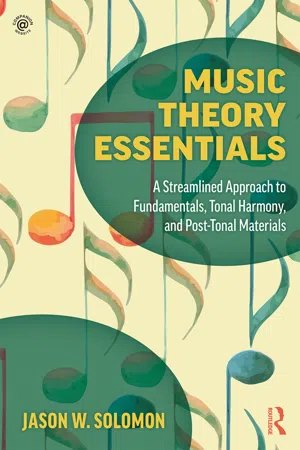
Music Theory Essentials
A Streamlined Approach to Fundamentals, Tonal Harmony, and Post-Tonal Materials
- 302 pages
- English
- ePUB (mobile friendly)
- Available on iOS & Android
Music Theory Essentials
A Streamlined Approach to Fundamentals, Tonal Harmony, and Post-Tonal Materials
About this book
Music Theory Essentials offers an antidote to music theory textbooks that are overly long and dense. Focusing on the essentials, this text provides a clear-cut guide to the key concepts of music theory. Beginning with no assumptions about music theory knowledge, the book covers the core elements of music fundamentals, diatonic and chromatic harmony, post-tonal theory, and popular music in a single concise volume. Emphasizing critical thinking skills, this book guides students through conceptualizing musical concepts and mastering analytic techniques.
Each chapter concludes with a selection of applications designed to enhance engagement:
- Exercises allow students to apply and practice the skills and techniques addressed in the chapter.
- Brain Teasers challenge students to expand their musical understanding by thinking outside the box.
- Exploring Music offers strategies for students to apply learned concepts to the music they are currently learning or listening to.
- Thinking Critically encourages students to think more deeply about music by solving problems and identifying and challenging assumptions.
A companion website provides answers to book exercises, additional downloadable exercises, and audio examples.
Straightforward and streamlined, Music Theory Essentials is a truly concise yet comprehensive introduction to music theory that is accessible to students of all backgrounds.
Frequently asked questions
- Essential is ideal for learners and professionals who enjoy exploring a wide range of subjects. Access the Essential Library with 800,000+ trusted titles and best-sellers across business, personal growth, and the humanities. Includes unlimited reading time and Standard Read Aloud voice.
- Complete: Perfect for advanced learners and researchers needing full, unrestricted access. Unlock 1.4M+ books across hundreds of subjects, including academic and specialized titles. The Complete Plan also includes advanced features like Premium Read Aloud and Research Assistant.
Please note we cannot support devices running on iOS 13 and Android 7 or earlier. Learn more about using the app.
Information
Part I
Fundamentals
1
Pitch and Notation
Pitch



The Notation of Pitch
Table of contents
- Cover
- Half Title
- Title Page
- Copyright Page
- Dedication Page
- Table of Contents
- Preface
- Acknowledgements
- Part I Fundamentals
- Part II Diatonic Harmony
- Part III Chromatic Harmony
- Part IV Post-Tonal and Popular Materials
- Appendix: List of Set Classes
- Credits
- Notes on the Text
- Index of Musical Examples
- Index of Terms and Concepts